
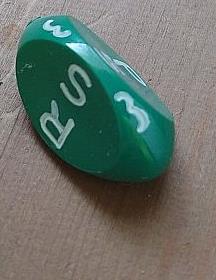
I added some photographs of dice from my own collection to the page about polyhedral dice used in role-playing games, but as that page has been getting longer and longer, to avoid making it too slow to download, I have now felt compelled to move the bulk of the photographs to this separate page, despite the fact that I felt that these photos of examples of the more unusual types of dice would have made the discussion concerning such dice easier to follow. However, I have since fixed that, by splitting the discussion into multiple pages, so that this page can be at the correct position in the discussion.


First, here is an image of two examples of a d3 achieved in the simplest possible way, by repeating the numbers from 1 to 3 twice on an ordinary six-sided cubical die. In one case, to make the die easier to distinguish from the ordinary d6, Roman numerals are used.
Following is an image of a three-sided die with three sides. Since three is an odd number, on the large faces, the scheme found on the tetrahedral d4 is resorted to: the letters R, P, and S are placed on the three faces, with two of them on each face, and the letter that comes up is the one that is, on both visible faces, next to the edge that is at the top. But in addition, a small face, rounded so the die cannot land on it, is placed between each large face, and the numbers 1, 2, and 3 are placed on the small faces, so that one of them can simply be read from the uppermost face. Due to the shape chosen for this die, these numbers are printed twice so they can be placed on the wider parts of the small faces.

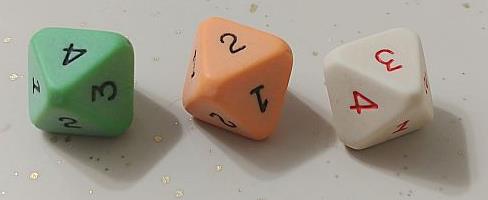
In the first of the two images above, a conventional tetrahedral d4 is shown on the right, with three numbers on each face associated with the corners of that face, so that it is convenient to see the number associated with the corner of the die that is on top. On the left is an unconventional one, which rounds off the corners, and puts the numbers on the corners, so that they need only be printed once.
The second image shows three octahedral dice with the numbers from 1 to 4 printed on them twice, thus avoiding the difficulties that the tetrahedral shape presents.

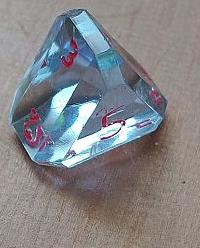
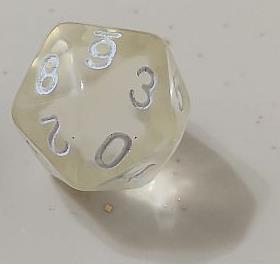
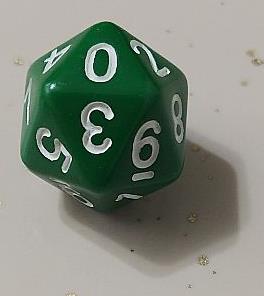
In the first image, there are shown three different approaches to making a d5. On the left is shown the one which I think is best: take an icosahedral die, and repeat each of the digits from 1 to 5 four times on its faces. In the center is the twisted bipyramid most commonly used nowadays for the d10, with the numbers from 1 to 5 repeated two times on its faces. Finally, on the right, is a die with only five sides; it is in the shape of a triangular prism with some rounded edges: two numbers are printed on the triangular faces, and the other three numbers are on the rounded edges between rectangular faces.
The d5 on the right is an example of what I would call an odd-shaped die; the faces aren't all identical, so one is not automatically led to the conclusion that it will be nearly fair, but no doubt it's good enough for a game played purely for amusement, as the sizes of the faces have been adjusted to seem to match.
Next is another image of a d5 of the type shown on the right of the previous image, this time a clear die.
Following the four examples of a d5, the next two images show examples of the icosahedral d10 of current manufacture. Yes, they're still making them; I found that using "0-9 twice" as one of my search terms is what makes it possible to find them.


In the first image, there are two twelve-sided dice. Both are dodecahedrons; but one uses spots rather than numerals to indicate its result. In the second image is a twelve-sided die in the shape of a rhombic dodecahedron instead.

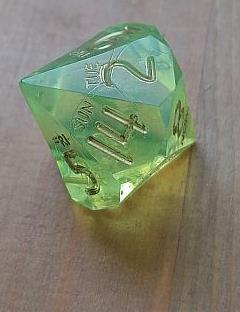
Here is a d14 along with two d7s. First is an odd-shaped d14, based on the cuboctahedron, but with the triangular faces enlarged to be hexagons with three short sides. Next is a d7 which is in the fair d14 shape of a twisted bipyramid, similar to a d10, but with seven rather than five faces on each side; as the shape is that of a d14, the numbers from 1 to 7 are repeated twice. One odd shape for the d7 is a pentagonal prism with rounded corners, similar to the odd-shaped d5 based on the triangular prism seen above, but the odd-shaped d7 shown on the right of this image seems to be an even odder shape which I am at a loss to describe.
Following this image with three dice is an image of a clear 14 in the fair twisted bipyramidal shape.
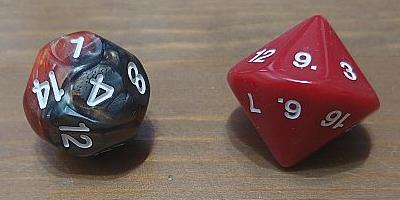
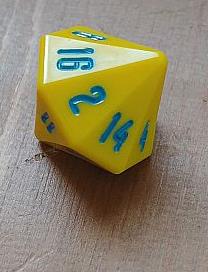
On the left is an odd-shaped d16, which I also have trouble describing. On the right is a bipyramidal d16. Since 16 is a multiple of four, each pyramid has an even number of sides, and so no twist is required.
Following is another image of a bipyramidal d16.
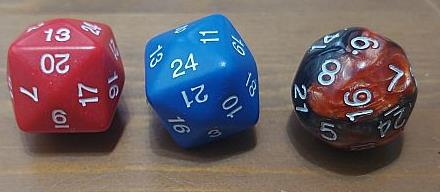
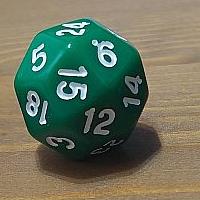
The first image shows two of the common type of d24, one on the left and one in the center, where a shallow pyramid is placed on each face of a cube, and one rounded d24 with kite-shaped faces instead on the right. Following that, the second image shows a d24 with kite-shaped faces without the extra rounding.
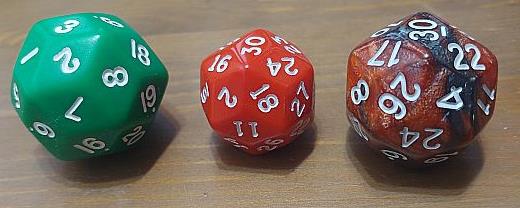
Here are three d30s, all in the shape of a rhombic triacontahedron.
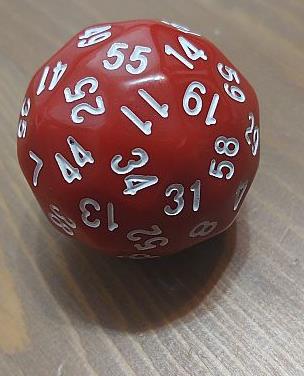
Here is a d60, with kite-shaped faces, this shape also being known as a trapezium, thus making the die a trapezohedron.
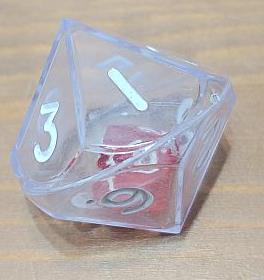
And finally here is a fair approach to the d100: place an opaque d10 within a clear plastic shell also in the shape of a d10, so that a single object serves as two dice.